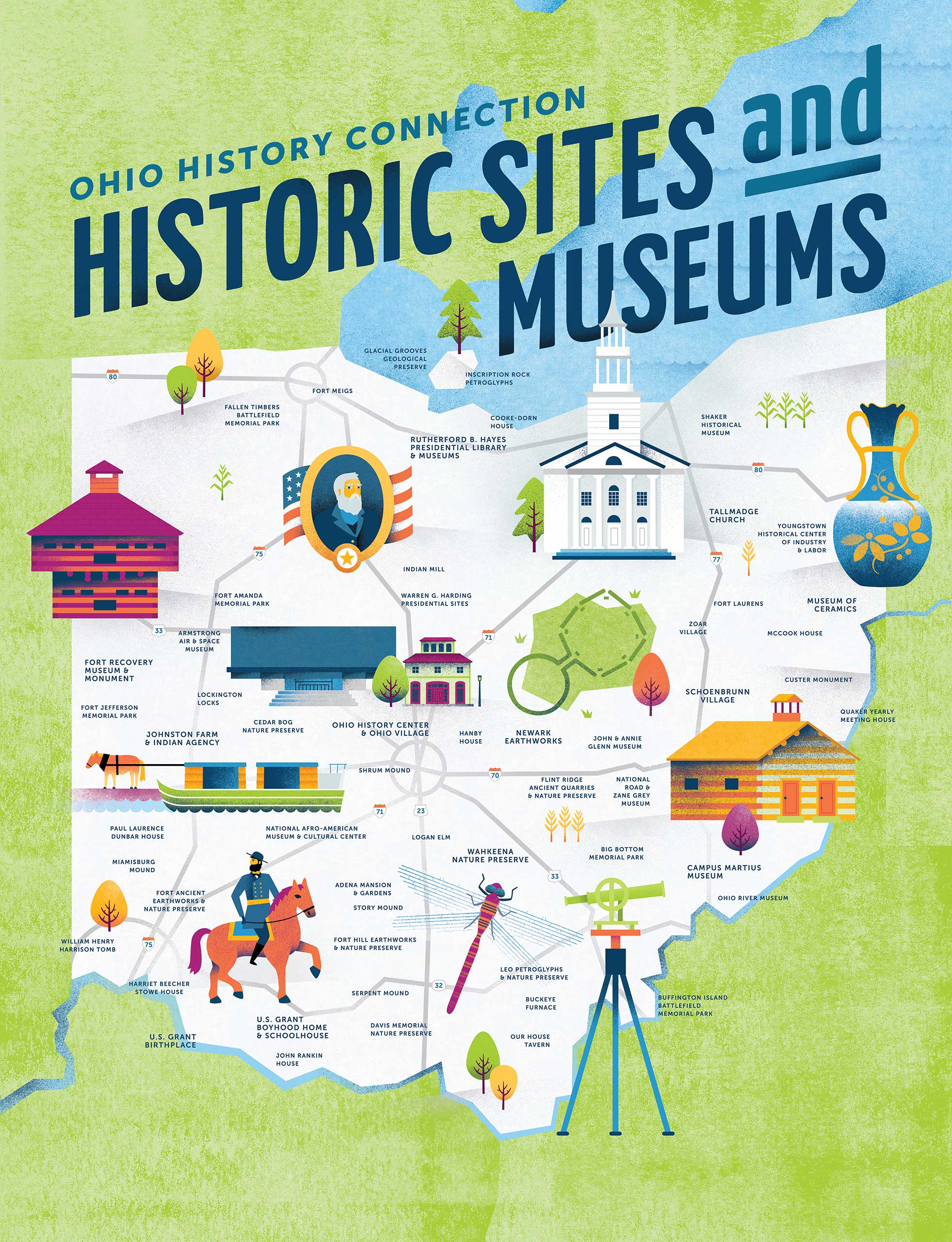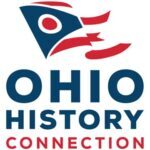All Ohio History Connection Museums and Attractions
Search by topic, region, site activities or site type.
Discover museums and historic sites about the topics you enjoy most. Download our site map.
Search by topic, region, site activities or site type.

See a moon rock, two full-sized aircraft flown by Neil Armstrong, the Gemini VIII space capsule, artifacts from the Apollo 11 mission and more.
Walk a mile-long boardwalk through this 450-acre preserve, a haven for many rare plants and animals including some that are Ice Age remnants.
Get a look at comfortable small-town life of the 1950s in the home of local industrialist Randolph Dorn and his wife, Estelle, built in 1844 for Civil War financier Jay Cooke’s father.
See monuments honoring Maj. Gen. Anthony Wayne and the soldiers and American Indians who died in 1794 during the
final battle of the Northwest Indian War.
Visit the monument at the site of Fort Amanda, a major supply depot for the American army during the War of 1812, and enjoy a walk along the river.
Find a stone memorial recalling that this small park was the site of Fort Jefferson from 1791 to 1796. A confederacy of American Indians defeated Gen. Arthur St. Clair’s army in a 1791 battle that became known as “St. Clair’s Defeat,” and the army retreated to Fort Jefferson.
Explore the reconstructed War of 1812 log fort that’s one of the largest in America and learn more about Ohio's critical role in the war in the adjacent education center.
Explore the site of two battles between the U.S. Army and American Indians in the 1790s through reconstructed blockhouses, a stockade and museum. Visit the nearby monument.
Walk in the footsteps of Rutherford B. Hayes, a Civil War General, Ohio Governor and 19th President of the United States! Tour his restored mansion, walk the grounds of his estate, Spiegel Grove and explore the nation’s first presidential library and museum.
Visit the nation's first museum of milling, in an 1861 mill built on the site of a mill erected for the Wyandotte Indians. Learn the story of milling from ancient times to the present.
Visit the nation's first museum of milling, in an 1861 mill built on the site of a mill erected for the Wyandotte Indians. Learn the story of milling from ancient times to the present.
Find 2,000 years of history, from American Indian mounds through Ohio’s canal era, at this peaceful 250-acre site. Tour the 1829 Johnston home, the American Indian museum, explore the farm and ride a mule-drawn boat on the historic Miami and Erie Canal.
Explore the remnants of the Miami and Erie Canal, which opened in 1845, linking Cincinnati and the Ohio River to Toledo and Lake Erie.
Visit the site of George Armstrong Custer’s birthplace and see the monument to the young soldier whose "Last Stand" made him a household name.
Explore the site of Ohio’s only Revolutionary War fort, built in 1778 as a wilderness outpost, and visit a museum that tells the story of soldiers on the frontier
Tour the pre-civil war home of Daniel McCook, now a museum honoring this Ohio family remembered as the "Fighting McCooks” for the large number of members who served in the Civil War.
Get fired up in the nation’s Pottery Capital at a museum devoted to wares made by the hundreds of potteries that once operated in the area. See the largest public display of the rare American porcelain, Lotus Ware.
Tour the first Quaker yearly meeting house west of the Alleghenies. Built in 1814, it was the center of a community important in the antislavery movement. It was used regularly until 1909.
Tour this reconstructed Delaware Indian mission community of the 1770s and see log buildings, gardens and the original mission cemetery.
Discover Shaker Heights through the story of the North Union Shakers who once lived on the site of today's Shaker Heights, plus exhibits telling the story of the planned suburban community developed there in the early 20th century.
Step inside an 1825 Federal-style church that’s an architectural landmark and reminder of northeast Ohio’s New England heritage.
Learn about the steel industry that dominated Youngstown in the 20th century and check out the “last heats,” the final batches of steel produced at each of the mills before they closed.
Explore a one-of-a-kind village, home from 1817 to 1898 of a communal society of German religious dissenters. Visit restored Zoarite buildings and enjoy a walk in Zoar’s big public garden, preserved and maintained as it was in the 1800s.
Hike trails through the 533-acre preserve and see ancient pits left by American Indians who came from far and wide to quarry flint here. In an on-site museum, learn about the official state gemstone.
Visit the family home of Benjamin Hanby—abolitionist, teacher, minister and composer of songs including the Christmas favorite, Up on the Housetop. The home was also a busy station on the Underground Railroad.
Visit the site said to be the place where, in 1774, Chief Logan of the Cayuga tribe delivered an eloquent speech on relations between American Indians and early Ohio settlers.
Visit the Great Circle Earthworks, Octagon Earthworks and Wright Earthworks, remnants of a 2,000 year-old complex that is the largest set of geometric earthworks ever known.
Enjoy exhibits on Ohio history, archaeology, natural history and more; explore a recreated 19th-century Ohio community; or use our vast library to explore Ohio history on your own at our centrally located flagship site.
Walk around one of the last ancient cone-shaped burial mounds remaining in Columbus, located in one-acre Campbell Park.
Find a nature center, hiking trails, stone outcroppings, an abundance of plants, native orchids and more than 100 species of birds at this 150-acre preserve that lives up to its name, meaning “most beautiful.”
Tour the restored home of the 29th president of the United States and visit one of the most beautiful presidential memorials, located about one and a half miles from the Harding Home.
Visit the imposing hilltop home of early Ohio statesman Thomas Worthington, designed by America’s first architect, Benjamin Latrobe. Explore the gardens, grounds and outbuildings and tour the Education and Visitor Center where you can learn more about Worthington and Adena.
Hike trails and see an impressive geologic fault that vertically displaced the earth 30 feet, exposing cliffs formed over 400 million years ago.
Explore North America’s largest ancient hilltop enclosure, built 2,000 years ago. Explore an on-site museum, recreated American Indian garden, and miles of hiking trails with scenic overlooks.
Visit one of the best-preserved American Indian hilltop enclosures in North America and see an impressive variety of bedrock, soils, flora and fauna.
Visit the Cincinnati home where Harriet Beecher Stowe lived from 1833 to 1836, formative years that later led her to write the best-selling novel Uncle Tom’s Cabin. Learn about the author, the Underground Railroad and women’s rights movements of the 1830s–1860s.
Visit this restored home on a bluff overlooking the Ohio River and hear how the Rev. John Rankin family, with neighbors in Ripley and other nearby communities, helped over 2,000 fugitives escape from slavery to freedom via the Underground Railroad.
See the largest cone-shaped burial mound in Ohio, constructed by people of the ancient Adena culture (800 B.C.–A.D. 100).
Enjoy regularly changing exhibits and special programs sharing African American history, art, and culture at this museum in Wilberforce, home of two historically black universities, Wilberforce and Central State.
Tour the restored home of poet Paul Laurence Dunbar (1872–1906), who gained international acclaim as a writer and voice for equality for African Americans.
See the largest and finest serpent effigy earthwork in the world, likely built by people of the Fort Ancient culture circa A.D. 1100. Follow a footpath around the serpent and hike wooded trails nearby.
Find Story Mound, constructed by people of the Adena culture (800 B.C.–A.D. 100) and excavated in 1897, in a Chillicothe neighborhood.
Visit President Ulysses S. Grant’s birthplace in Point Pleasant and learn how the Civil War hero has been honored.
Explore young Ulysses Grant’s life by visiting his school and his boyhood home, restored to its appearance in 1839, the year Grant left for West Point.
See the monument and tomb of William Henry Harrison, ninth president of the United States, and learn about his life and accomplishments.
Visit the site of a 1791 attack on settlers by American Indians that marked the start of four years of warfare in Ohio. See a monument marking the site, which earned its name from the large floodplain on which it is located.
Visit Buckeye Furnace and learn how iron-making complexes much like this one scattered across rural southern Ohio in the 19th century helped win the Civil War. See the original blast furnace, reconstructed furnace buildings, museum and nature trails.
Visit the site of the only significant Civil War battle on Ohio soil and see a monument commemorating it. Spoiler Alert: the battlefield is near the bank of the Ohio River, not on the nearby island.
Explore the museum and learn about Campus Martius, a civilian stockade built in 1788 as the first organized American settlement in the Northwest Territory. See the 1788 Ohio Company Land Office and the Rufus Putnam House, once part of the Campus Martius stockade.
Explore the childhood home of NASA astronaut and Ohio's longest serving U.S. Senator, John Glenn. Experience life during the Great Depression and on the home front during WWII.
See ancient American Indian carvings in sandstone on the edge of a beautiful ravine—outstanding examples of American Indian rock art thought to date between A.D. 1000 and 1550.
Learn about U.S. 40, the old National Road that came to be called “the Main Street of America,” explore the adventure novels and Westerns of Zanesville author Zane Grey, and see examples of the art pottery for which this region of Ohio was famous in the 20th century.
Explore the story of the Ohio River and step aboard the W.P. Snyder Jr., the nation’s last intact steam-powered, stern-wheeled towboat.
Tour a restored Federal-style tavern built in 1819 that hosted the Marquis de Lafayette when he visited French-founded Gallipolis during his tour of the United States in 1825.
